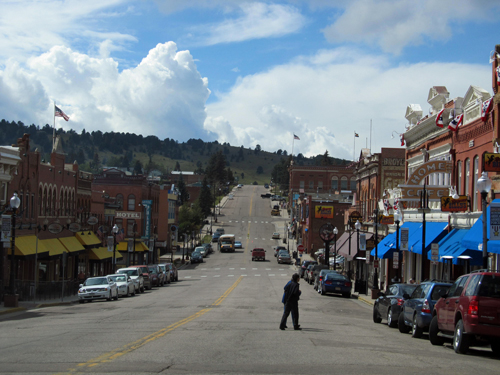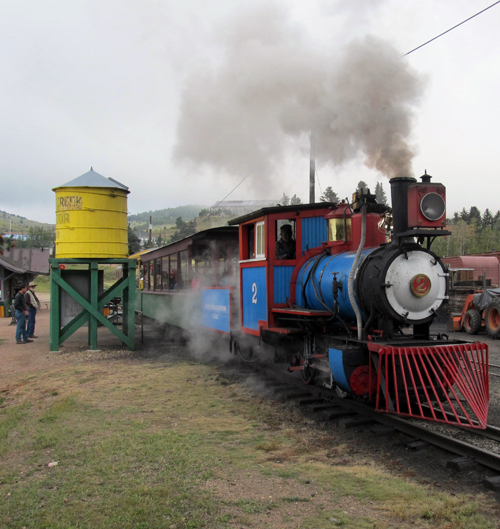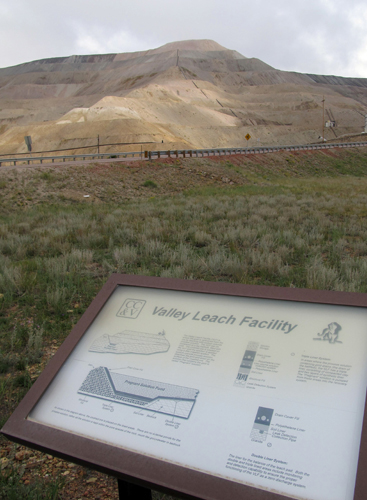Wednesday, July 02 2014
The Town of Cripple Creek, Colorado
In addition to its golden history, the restored town of Cripple Creek is now known for its casinos. Limited stakes gambling was approved by Colorado voters in 1990, so visitors can try to strike it rich 24 hours a day. If cards or craps or one-armed bandits don’t hold any appeal, skip the dozen or so casinos in town and instead enjoy the town’s many other attractions.
The Cripple Creek District Museum is housed in five original historic buildings— all filled with antiques and mining equipment. The Cripple Creek Heritage Center is a great place to learn about the entire Pikes Peak region. Looking for a highlight found in low lighting conditions? The Mollie Kathleen Gold Mine is located just outside of town, and is America’s only vertical shaft mine tour. After descending 100 stories, ride an air-powered mine train and learn how hard rock miners followed veins of gold. This historic mine was founded in 1891 and is named for its owner, Mollie Kathleen Gortner, the first woman in history to register a mining claim in her own name. Cripple Creek and Victor Gold Mining Company (CC&V) As you drive through the mining district today, you will see signs of active mining in just about every phase. The Cripple Creek and Victor Gold Mining Company (CC&V) operates a low-grade, surface gold mine, the largest in Colorado, between Cripple Creek and Victor. CC&V is doing extremely well and has poured in excess of 4 million ounces of gold from its Cresson Mine. CC&V, which has operated in the district for nearly 40 years, began its Cresson Project in 1995. The Cresson is named for the historic underground mining operation that was responsible for the famous great gold find of 1914— the “Cresson Vug.” A vug is a cavity in the rock, lined with crystals somewhat like a geode. The Cresson Vug produced 60,000 troy ounces of gold that was essentially picked from the walls of a room-sized void 1,200 feet below the surface. What a bonanza! If you’d like to see a working gold mining operation, CC&V hosts seasonal tours. Don’t miss this exciting opportunity to see giant haul trucks, shovels, and drill rigs in action. Watch boulders being crushed into gravel and learn about the safe, environmentally responsible mining and refining methods. Once you’ve seen a modern-day mining operation for yourself, you’ll gain another level of appreciation for the old-timers who didn’t have it so easy! And after learning about reclamation standards, you can set the record straight with those who argue that mining does nothing but permanently destroy the earth. Under current permits, CC&V plans to continue recovering gold here until at least 2026. If underground mining is resumed (exploratory results look good), work could be extended another dozen or so years beyond that. With an average pay and benefits package worth $80,000, several thousand CC&V employees are enjoying good paying jobs!
Comments:
|






 The gold rush not only brought prospectors into the quiet ranch town of Cripple Creek, but it brought in goods and services needed by those miners. Lumber yards, hotels, 100 saloons, 91 lawyers, 80 doctors, 40 assay offices, 14 newspapers, three railroads, two electric streetcar systems, and a trolley turned a small town into a booming gold camp of over 50,000. Interestingly enough, Cripple Creek was also the site of some of the worst mining labor conflicts in American history, culminating in the state militia being called in in 1903. Several celebrities also spent time here, including comedian and film star Groucho Marx, lawman and gambler Wyatt Earp, and boxer Jack Dempsey. Unfortunately, two accidental fires burned much of the city in 1896. Wisely, however, the city fathers declared that the business district be rebuilt in brick, and so many of those rebuilt buildings are still standing.
The gold rush not only brought prospectors into the quiet ranch town of Cripple Creek, but it brought in goods and services needed by those miners. Lumber yards, hotels, 100 saloons, 91 lawyers, 80 doctors, 40 assay offices, 14 newspapers, three railroads, two electric streetcar systems, and a trolley turned a small town into a booming gold camp of over 50,000. Interestingly enough, Cripple Creek was also the site of some of the worst mining labor conflicts in American history, culminating in the state militia being called in in 1903. Several celebrities also spent time here, including comedian and film star Groucho Marx, lawman and gambler Wyatt Earp, and boxer Jack Dempsey. Unfortunately, two accidental fires burned much of the city in 1896. Wisely, however, the city fathers declared that the business district be rebuilt in brick, and so many of those rebuilt buildings are still standing.  A four-mile narrated ride on the Cripple Creek & Victor Narrow Gauge Railroad passes several historical sites that can only be seen from the rails. The train is pulled by a coal-fired steam locomotive that looks a bit like Thomas the Tank Engine thanks to the baby blue paint. You can also see what it would have been like to be part of the criminal element in the early 1900s by visiting the Cripple Creek Jail Museum. It is housed in the red brick building that served as the Teller County jail from 1902 until the 1990s. The original cells are there, along with displays that highlight the laws and lawlessness of the 1890s.
A four-mile narrated ride on the Cripple Creek & Victor Narrow Gauge Railroad passes several historical sites that can only be seen from the rails. The train is pulled by a coal-fired steam locomotive that looks a bit like Thomas the Tank Engine thanks to the baby blue paint. You can also see what it would have been like to be part of the criminal element in the early 1900s by visiting the Cripple Creek Jail Museum. It is housed in the red brick building that served as the Teller County jail from 1902 until the 1990s. The original cells are there, along with displays that highlight the laws and lawlessness of the 1890s.  On Highway 67 between the towns of Cripple Creek and Victor, you will cross the highest bridge on the Colorado State Highway system. The bridge across Arequa Gulch was built in 2000-2001 for $418 million by the CC&V to accommodate their expansion. The 1,218 foot long bridge is over 250 feet tall at its highest point. The road is currently being rerouted again due to more growth. Near the bridge is CC&V’s leach facility and gold ore processing plant. The Valley Leach Facility (VLF) is where the gold is recovered from the ore by leaching with a sodium cyanide process solution. You can’t miss what looks like giant rock piles. The VLF actually functions like a big bathtub filled with crushed ore. The solution is applied to the ore using a drip irrigation system. The sodium cyanide process solution dissolves the gold and silver on the surface of the rock. The “bathtub” has a triple thick liner and a state-of-the-art monitoring and detection system to ensure zero discharge. The gold-bearing solution (called "pregnant solution”) is captured at the bottom of the liners. Gold is then recovered from the pregnant solution with a carbon absorption process. North of the VLF is the crushing facility that can process approximately 50 tons of ore per minute. Trucks load up the pulverized ore and delivery it to the VLF. This process recovers a whopping 200,000 ounces of gold annually. Eureka!
On Highway 67 between the towns of Cripple Creek and Victor, you will cross the highest bridge on the Colorado State Highway system. The bridge across Arequa Gulch was built in 2000-2001 for $418 million by the CC&V to accommodate their expansion. The 1,218 foot long bridge is over 250 feet tall at its highest point. The road is currently being rerouted again due to more growth. Near the bridge is CC&V’s leach facility and gold ore processing plant. The Valley Leach Facility (VLF) is where the gold is recovered from the ore by leaching with a sodium cyanide process solution. You can’t miss what looks like giant rock piles. The VLF actually functions like a big bathtub filled with crushed ore. The solution is applied to the ore using a drip irrigation system. The sodium cyanide process solution dissolves the gold and silver on the surface of the rock. The “bathtub” has a triple thick liner and a state-of-the-art monitoring and detection system to ensure zero discharge. The gold-bearing solution (called "pregnant solution”) is captured at the bottom of the liners. Gold is then recovered from the pregnant solution with a carbon absorption process. North of the VLF is the crushing facility that can process approximately 50 tons of ore per minute. Trucks load up the pulverized ore and delivery it to the VLF. This process recovers a whopping 200,000 ounces of gold annually. Eureka!